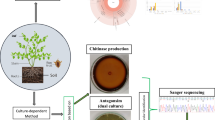Abstract
Labyrinthula terrestris, the causal agent of rapid blight disease in cool-season turfgrasses, is the first Labyrinthula species found to be associated with higher plants in terrestrial ecosystems. An initial study suggested a single common genotype associated with turfgrass in the US, but a later study revealed genetic diversity in this pathogen. In the present study, genetic diversity as well as differences in pathogenicity and morphology was determined in Labyrinthula spp. from turfgrasses in New Mexico and Arizona where rapid blight had not previously been identified. In total, 96 Labyrinthula isolates from New Mexico and four from Arizona were sequenced in 2011 and 2012. A phylogenetic approach based on 18S and ITS-LSU of ribosomal DNA was used for genotypic diversity, and pathogenicity and microscopy were used for phenotypic diversity. A maximum parsimony analysis revealed four genetic groups including two previously described Labyrinthula groups, Laby10 (L. terrestris) and Laby31. Laby10 was the most predominant with 70 % of isolates followed by Laby31 with 24 %. Two new groups, Laby879 and Laby2020, contained only five and one isolate, respectively. An association between genotypes and phenotypes was observed. Laby10 and Laby31 were highly virulent as well as larger in cell size (14.9 and 18.1 μm, respectively), while Laby879 was less virulent with an average cell size of 8.5 μm. Laby2020 was the smallest (0.8 μm) and non-pathogenic. Results showed a prevalence of pathogenic and non-pathogenic Labyrinthula spp. in turfgrasses in New Mexico and the presence of the Laby31 group in the US for the first time.

Similar content being viewed by others
References
Amon, J. P. (1978). Thraustochytrids and Labyrinthulids of terrestrial, aquatic and hypersaline environments of the Great Salt Lake, USA. Mycologia, 70, 1299–1301.
Armiger, L. C. (1964). An occurrence of Labyrinthula in New Zealand Zostera. New Zealand Journal of Botany, 2, 3–9.
Aschner, M. (1958). Isolation of Labyrinthula macrocystis from soil. Bulletin of the Research Council of Israel, 6D, 174–179.
Bergmann, N., Fricke, B., Schmidt, M. C., Tams, V., Beining, K., Schwitte, H., Boerrcher, A. A., Martin, D. L., Bockelmann, A. C., Reusch, T. B., & Rauch, G. (2011). A quantitative real-time polymerase chain reaction assay for the seagrass pathogen Labyrinthula zosterae. Molecular Ecology Resources, 11(6), 1076–1081.
Bigelow, D. M., Olsen, M. W., & Gilbertson, R. L. (2005). Labyrinthula terrestris sp. nov. a new turfgrass pathogen. Mycologia, 97, 185–190.
Brakel, J., Werner, F. J., Tams, V., Reusch, T. B. H., & Bockelmann, A. C. (2014). Current European Labyrinthula zosterae are not virulent and modulate seagrass (Zosterae marina) defense gene expression. PLoS One. doi:10.1371/journal.pone.0092448.
Camberato, J. J., Peterson, P. D., & Martin, S. B. (2006). Salinity and salinity tolerance alter rapid blight in Kentucky bluegrass, perennial ryegrass, and slender creeping red fescue. Applied Turfgrass Science. doi:10.1094/ATS-2006-0213-01-RS.
Craven, K. D., Peterson, P. D., Windham, D. E., Mitchell, T. K., & Martin, S. B. (2005). Molecular identification of the turf grass rapid blight pathogen. Mycologia, 97, 163–169.
Douhan, G. W., Olsen, M. W., Herrell, A., Winder, C., Wong, F., & Entwistle, K. (2009). Genetic diversity of Labyrinthula terrestris, a newly emergent plant pathogen, and the discovery of new Labyrinthulid organisms. Mycological Research, 113, 1192–1199.
Entwistle, C. A., Olsen, M. W., & Bigelow, D. M. (2005). First report of a Labyrinthula spp. causing rapid blight of Agrostis capillaris and Poa annua on amenity turfgrass in the UK. Plant Pathology, 55, 306.
Garcias-Bonet, N., Sherman, T. D., Duarte, C. M., & Marba, N. (2011). Distribution and pathogenicity of the Protist Labyrinthula sp. in western Mediterranean Seagrass Meadows. Estuaries and Coasts. doi:10.1007/s12237-011-9416-4.
Kerrigan, J. L., Olsen, M. W., & Martin, S. B. (2012). Rapid blight of turfgrass. The Plant Health Instructor. doi:10.1094/PHI-I-2012-0621-01.
Kohout, M., Olsen, M. W., & Bigelow, D. M. (2004). Effect of salinity and cutting on symptom development of rapid blight of perennial rye. Phytopathology, 94, S54.
Muehlstein, L. K., Porter, D., & Short, F. T. (1991). Labyrinthula zosterae sp. nov., the causative agent of wasting disease of eelgrass, Zostera marina. Mycologia, 83, 180–191.
Olsen, M. W., & Kohout, M. J. (2006). Isolation of the rapid blight pathogen, Labyrinthula terrestris, from bermudagrass in Arizona. Super Journal of PACE Turfgrass Research online publication: http://www.paceturf.org/PTRI/Documents/051121sj.pdf.
Olsen, M. W., Bigelow, D. M., Gilbertson, R. L., Stowell, L. J., & Gelernter, W. D. (2003). First report of a Labyrinthula sp. causing rapid blight disease of rough bluegrass and perennial ryegrass. Plant Disease, 87, 1267.
Olsen, Y. S., Potouroglou, M., Garcias-Bonet, N., & Duarte, C. M. (2015). Warming reduces pathogen pressure on a climate-vulnerable seagrass species. Estuaries and Coasts, 38, 659–667.
Stowell, L. J., Martin, S. B., Olsen, M. W., Bigelow, D., Kohout, M., Peterson, P. D., Camberato, J., & Gelernter, W. D. (2005). Rapid blight: A new plant disease. American Phytopathological Society Feature Article. http://www.apsnet.org/online/feature/rapid/.
Stucky, B. J. (2012). SeqTrace: a graphical tool for rapidly processing DNA sequencing chromatograms. Journal of Biomolecular Techniques, 23, 90–93.
Sullivan, B. K., Sherman, T. D., Damare, V. S., Lilje, O., & Gleason, F. H. (2013). Potential roles of Labyrinthula spp. in global seagrass population declines. Fungal Ecology, 6, 328–338.
Tamura, K., Peterson, D., Peterson, N., Stecher, G., Nei, M., & Kumar, S. (2011). MEGA5: Molecular evolutionary genetics analysis using maximum likelihood, evolutionary distance, and maximum parsimony methods. Molecular Biology and Evolution, 28, 2731–2739.
Vergeer, L. H. T., & den Hartog, C. (1994). Omnipresence of Labyrinthulaceae in seagrasses. Aquatic Botany, 48, 1–20.
Acknowledgments
We thank Dr. Bernd Leinauer and Jason French, New Mexico State University, for collecting turf samples in Las Cruces, New Mexico in 2011 and 2012 and the Southwest Consortium on Plant Genetics and Water Resources for partial funding
Author information
Authors and Affiliations
Corresponding authors
Rights and permissions
About this article
Cite this article
Chitrampalam, P., Goldberg, N. & Olsen, M.W. Labyrinthula species associated with turfgrasses in Arizona and New Mexico. Eur J Plant Pathol 143, 485–493 (2015). https://doi.org/10.1007/s10658-015-0701-0
Accepted:
Published:
Issue Date:
DOI: https://doi.org/10.1007/s10658-015-0701-0




